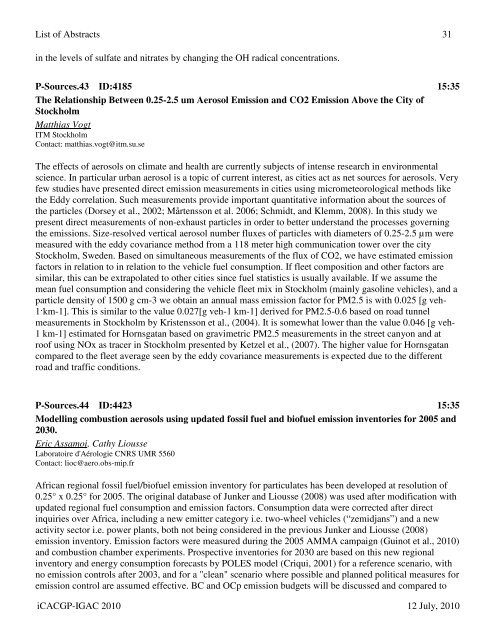Download Abstracts Here - IGAC Project
Download Abstracts Here - IGAC Project
Download Abstracts Here - IGAC Project
Create successful ePaper yourself
Turn your PDF publications into a flip-book with our unique Google optimized e-Paper software.
List of <strong>Abstracts</strong> 31in the levels of sulfate and nitrates by changing the OH radical concentrations.P-Sources.43 ID:4185 15:35The Relationship Between 0.25-2.5 um Aerosol Emission and CO2 Emission Above the City ofStockholmMatthias VogtITM StockholmContact: matthias.vogt@itm.su.seThe effects of aerosols on climate and health are currently subjects of intense research in environmentalscience. In particular urban aerosol is a topic of current interest, as cities act as net sources for aerosols. Veryfew studies have presented direct emission measurements in cities using micrometeorological methods likethe Eddy correlation. Such measurements provide important quantitative information about the sources ofthe particles (Dorsey et al., 2002; Mårtensson et al. 2006; Schmidt, and Klemm, 2008). In this study wepresent direct measurements of non-exhaust particles in order to better understand the processes governingthe emissions. Size-resolved vertical aerosol number fluxes of particles with diameters of 0.25-2.5 µm weremeasured with the eddy covariance method from a 118 meter high communication tower over the cityStockholm, Sweden. Based on simultaneous measurements of the flux of CO2, we have estimated emissionfactors in relation to in relation to the vehicle fuel consumption. If fleet composition and other factors aresimilar, this can be extrapolated to other cities since fuel statistics is usually available. If we assume themean fuel consumption and considering the vehicle fleet mix in Stockholm (mainly gasoline vehicles), and aparticle density of 1500 g cm-3 we obtain an annual mass emission factor for PM2.5 is with 0.025 [g veh-1·km-1]. This is similar to the value 0.027[g veh-1 km-1] derived for PM2.5-0.6 based on road tunnelmeasurements in Stockholm by Kristensson et al., (2004). It is somewhat lower than the value 0.046 [g veh-1 km-1] estimated for Hornsgatan based on gravimetric PM2.5 measurements in the street canyon and atroof using NOx as tracer in Stockholm presented by Ketzel et al., (2007). The higher value for Hornsgatancompared to the fleet average seen by the eddy covariance measurements is expected due to the differentroad and traffic conditions.P-Sources.44 ID:4423 15:35Modelling combustion aerosols using updated fossil fuel and biofuel emission inventories for 2005 and2030.Eric Assamoi, Cathy LiousseLaboratoire d'Aérologie CNRS UMR 5560Contact: lioc@aero.obs-mip.frAfrican regional fossil fuel/biofuel emission inventory for particulates has been developed at resolution of0.25° x 0.25° for 2005. The original database of Junker and Liousse (2008) was used after modification withupdated regional fuel consumption and emission factors. Consumption data were corrected after directinquiries over Africa, including a new emitter category i.e. two-wheel vehicles (“zemidjans”) and a newactivity sector i.e. power plants, both not being considered in the previous Junker and Liousse (2008)emission inventory. Emission factors were measured during the 2005 AMMA campaign (Guinot et al., 2010)and combustion chamber experiments. Prospective inventories for 2030 are based on this new regionalinventory and energy consumption forecasts by POLES model (Criqui, 2001) for a reference scenario, withno emission controls after 2003, and for a "clean" scenario where possible and planned political measures foremission control are assumed effective. BC and OCp emission budgets will be discussed and compared toiCACGP-<strong>IGAC</strong> 2010 12 July, 2010








